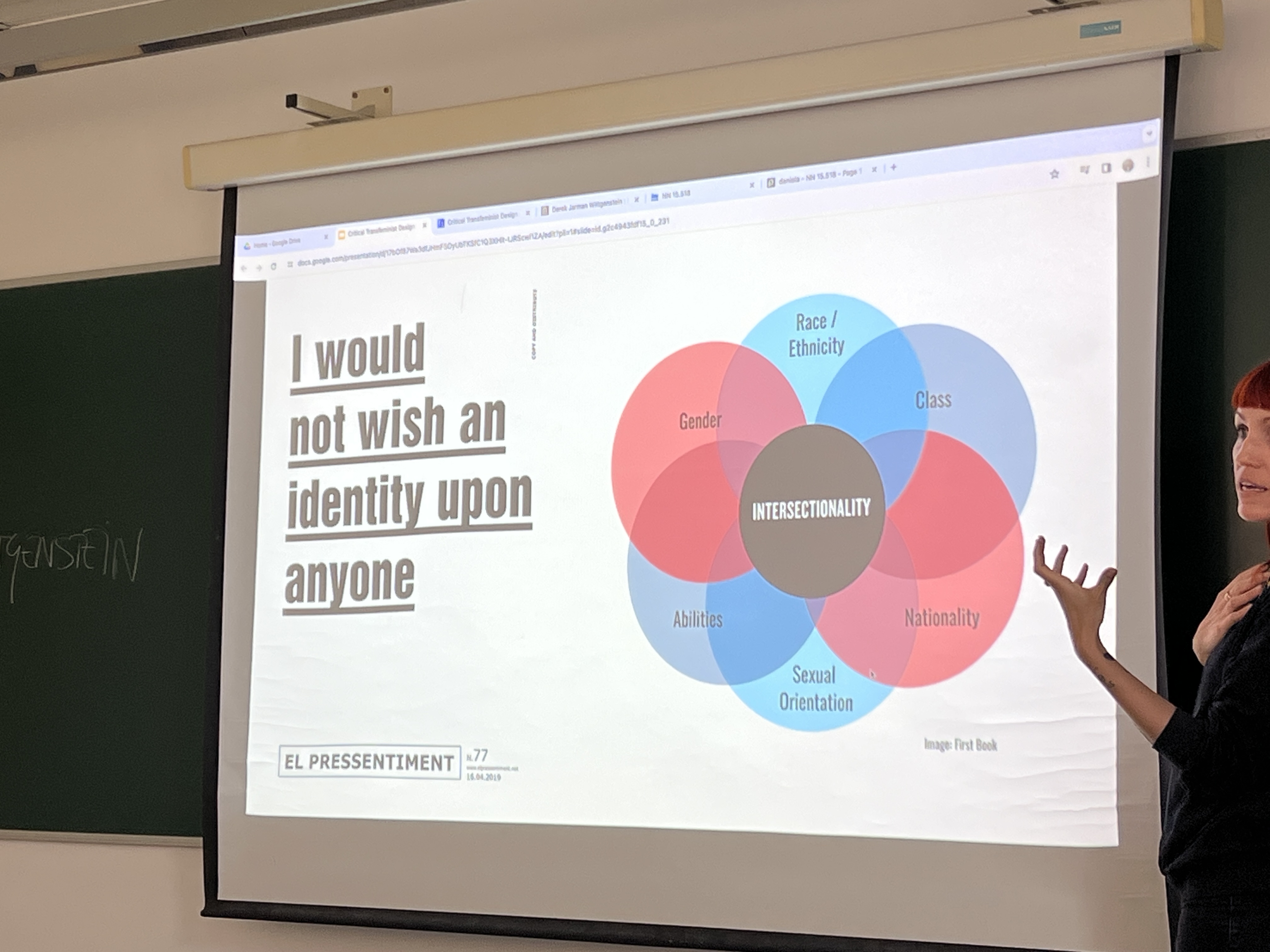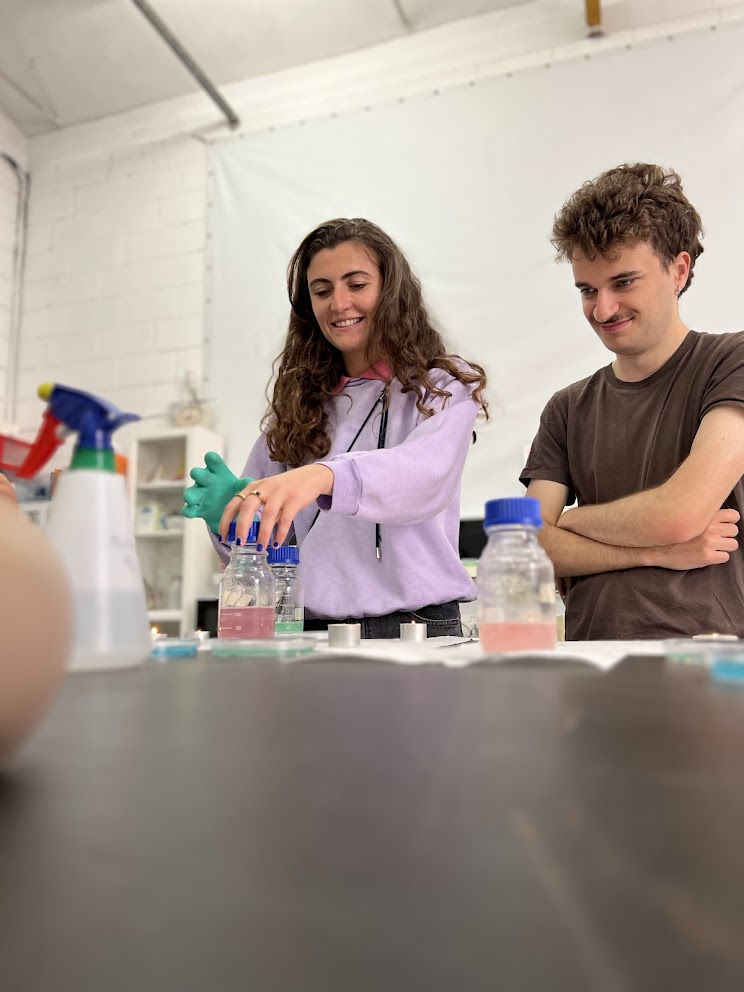Critical Transfeminist Design
Perspectives & Philosophies¶
Too Long Didn’t Read
Our Critical Transfeminist Design module, the final one of the term, was split into two classes. The first class delved into philosophical concepts like phenomenology, performativity, and subalternity, revealing deep connections between philosophy, feminism, and design. We discussed the impact of language on identity and explored the transformative potential of resignification, emphasizing inclusivity and equity in design.
The second class shifted to practical exploration, collecting samples to understand the microcosm of life and creating empathy through designing a fictional one-celled organism. While this hands-on approach was engaging, it felt somewhat disconnected from the critical transfeminist theory discussed earlier.
Overall, the module highlighted the importance of broad perspectives and diverse viewpoints in design, reminding me to consider the social implications of my work. However, I feel this course might be better placed earlier in the curriculum to align with our exploratory phase.
Our module on Critical Transfeminist Design (our last one of the term) was split into two classes, to help us explore how diverse and more than human perspectives can impact design decisions.
Exploring philosophies and unwrapping preconceptions¶
The first, took us deep into the philosophical underpinnings of how the body and identity have been conceptualized and stigmatized through Western philosophy, initially viewing the body either as marked by Christian moral imperatives (think original sin) or as a mechanistic entity — where the body is seen as just a cultural mechanism.
This evolved into discussions on phenomenology and the corporeal and symbolic dimensions of the body, highlighting thinkers like Husserl-Ponty and Heidegger, who emphasized the body’s central role in shaping human experience and interaction.
Which of course it would, it is the only means that we really have to truly process and understand the world, no matter what technologies and products we develop, our experiences of them are still fundamentally driven by our senses.
We explored the impact of language on identity, inspired by thinkers like Lacan, Foucault, and Butler, examining how language not only represents but also regulates and normalizes identity, creating potential for both conformity and resistance. The concept of performativity was particularly striking, illustrating how the body acts and reacts within the constraints of societal norms yet also possesses the capacity for rebellion and transformation.
The class also introduced the transformative potential of resignification, a process of giving new meanings to existing concepts, which can subvert and challenge normative structures. This idea was tied to broader discussions on the dynamic nature of norms and the potential for corrective practices that acknowledge and leverage the fluidity of identity.
We also engaged with the Contrasexual Manifesto by Paul B. Preciado, which argues for a radical freedom beyond traditional gender binaries, emphasizing the importance of liberation from predefined categories. This tied into discussions on Transfeminism, which broadens the scope of feminism to include all who are oppressed by cis-heteropatriarchy, challenging the binary gender system and advocating for a recognition of diverse gender identities.
Throughout the class, we were encouraged to think critically about the role of design in perpetuating or challenging these norms, considering how our own work can contribute to more just and inclusive societal structures. This was an interesting experience, that pushed me to consider not just the western centric aesthetics of design I’d grown so used to, but its deep social implications and the power it has to shape, and reshape, human lives.
Theory led exploration¶
The first class focused on theory, now it was time for practice. Our second and final session was about going out to explore the world around us, collecting samples of water, soil bark etc (much like a biology class back in school) to explore how we can learn about and understand the diverse microcosm of life that exists in these small samples. I think the point of this was to really drive home the fact that when we take make decisions that affect our own lives or the lives of other humans as well, but our decisions also have an effect on this tiny tiny world as well, and this can have far reaching consequences down the line if we create a series of imbalances.
Plus it was also really fun to be able to explore through a microscope the tiny world of microorganisms and bacteria.
As we wrapped up the class we took part in one final exercise, to create our own tiny one celled organism (on paper) and imagine it’s functions and abilities. It was a really great exercise in creating empathy, if we can convince ourselves to care about a non existent organism and how it would survive on our planet’s ecosystem, then we can continue to build on the empathy we build with each other and design some truly great solutions.
Final Thoughts¶
The first class on critical Transfeminist design theory was incredibly intriguing and eye-opening. We explored concepts like phenomenology, performativity, and subalternity, revealing the deep connections between philosophy, feminism, and design. It was fascinating to consider how people experience and express their bodies and identities in diverse ways. These discussions underscored the importance of inclusivity and equity in design practices, showing how understanding history and critical theory can shape our contemporary design work.
In contrast, the second class on methods of biological interaction felt somewhat disjointed. While creating our own one-cell organism was a fun and thought-provoking exercise, it seemed repetitive given similar activities we’ve done before. Although exploring different fields is enjoyable, I struggled to see the connection to the critical Transfeminist design concepts we discussed earlier. This had me thinking about the class’s place in the broader curriculum of the course and its relevance to most of our thesis projects at this point in time.
Perhaps this course would be more beneficial in term 1 or the beginning of term 2 when we’re still exploring various areas.
Despite all that, the course reminded me of the importance of maintaining a broad perspective in design and incorporating diverse viewpoints to avoid exclusionary practices.


